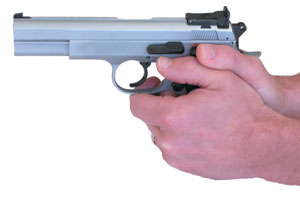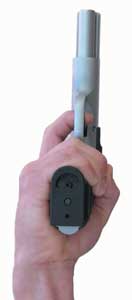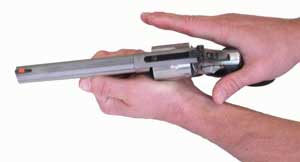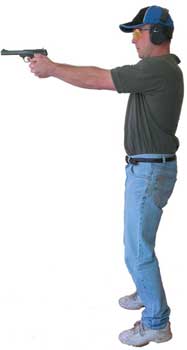Handgun shooting tips
by Ric Tester
Australian & New Zealand Handgun 1


 Always warm up
Always warm up
It is amazing how many pistol shooters begin a competition shoot without ‘getting their eye in’. Try to do some shooting just before competing, as the body needs time and practice in order to tune in to the task.
Go back to the basics
It is important to always be mindful of the basic principles that underpin good shooting technique, namely grip, stance, breathing, sight alignment, trigger release and follow through. Bad habits are like weeds - they begin unnoticed, but will gradually get a stranglehold on the elements of good technique if not kept in check. This is why it is so important - particularly to shooters who are not coached - to regularly self assess by checking their basic technical skills.
Practise dry firing
Nothing hides a technical fault better than a loud bang, a flash and a jumping muzzle. The accuracy of your shot will always be determined by the position of the gun at the exact moment of firing. The things that will generally destroy this are poor trigger technique and flinch. Regrettably, many shooters fail to improve their scores because of critical moment gun movement. The most effective way to cure and control this issue is, firstly, to practise dry firing as part of your training regime. As a guide, I would recommend that you actually do more dry firing than live firing at a practice session.
Check for flinch
Regularly check for flinch by having a partner load your gun for you - so that you do not know whether you will be pulling the trigger on a live round or a dummy. This is a tried and proven technique that is under-employed in many training schedules.
Select a pistol that fits your hand properly
Unfortunately, many shooters will fall into the trap of getting a gun that they like the look of, but which is a poor fit in their hand. Regrettably, not all gun styles fit all hands so it is important to prioritise one’s shooting needs before making a purchase. The stock of the gun will need to nestle into the hand so that the grip is comfortable and has no pressure points. It is very important that the index finger be positioned to allow an accurate and controlled movement when actuating the trigger.
Correct grip
The gun must be held so that its long axis lines up pretty well with the axis of the forearm, but will still allow sufficient extension of the finger to allow a straight trigger pull. If the wrist needs to be bent around the gun to allow the index finger to access the trigger, this generally means that the gun is too big for the hand. This follows on from the previous tip, in that some gun/hand combinations will simply not allow correct grip to be established and, in such cases, the combination will be less than optimum for good shooting.
Hold the gun tight
Hold the gun tight but not so much as to affect circulation. A correctly fitting grip will make it very easy to hold the gun tight and control recoil.
Trigger control
This is one of the most important aspects of shooting technique. The trigger should be eased back in a gentle, continuous motion. It should never be snapped or jerked. A shooter who is familiar with his or her gun will, from experience, be aware of the exact force needed to release the mechanism. In preparation for the shot, about 50 to 70 per cent of this force should already be on the trigger. When the mechanism lets go, the finger should be as close as possible to 90 degrees to the surface of the trigger.
 Follow through
Follow through
There is always a small amount of time between the trigger mechanism letting go and the bullet exiting the barrel. The hammer must fall upon the firing pin, which must depress the primer and then ignite the powder, which will burn and create the expanding gas that drives the bullet. Any movement during this period must be kept to a minimum (ideally zero). This is why it is so important to discipline yourself not to move a muscle until the bullet has passed through the target. This is commonly known as follow through.
Let the trigger move
fully forward at the same speed as you pressed it. After you have fired the shot and paused for the follow through, allow the trigger to slowly return to its unfired position. Do this at the same speed as you originally pressed it. Performing this task will further assist you to hold the gun still before firing.
Be consistent in your shooting
Accuracy walks hand-in-hand with consistency. Try to be as consistent as possible with things such as how you raise the gun to the target, how you establish your sight picture and how long it takes to settle and discharge the shot. Also try to keep the physical conditions constant, such as barrel temperature (this is controlled to some extent by the time between shots) and type of ammunition.
Correct breathing
This is traditionally one of the hardest skills to master. Normal breathing will cause enough movement to disturb the sight picture. The trick is not to think too much about breathing, because, quite often, the more we think about something, the more we allow it to disturb our concentration. Try to establish a cycle where the breath is momentarily held just before and just after the shot. This will in no way disturb the natural balance between oxygen and carbon dioxide in our bloodstream.
